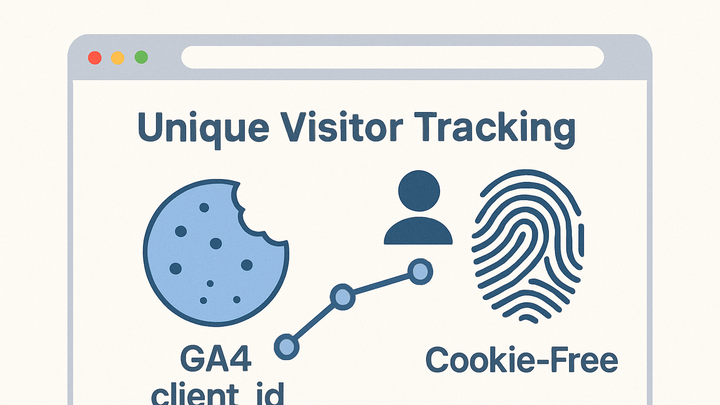Published on 2025-06-22T07:00:36Z
What is Client ID? Definition and Examples in GA4 and PlainSignal
Client ID is a unique identifier automatically generated by web analytics platforms to differentiate individual users based on their browser or device. In Google Analytics 4 (GA4), the Client ID is stored in the _ga cookie with a default expiration of two years, enabling the system to recognize returning visitors and compile accurate user metrics. PlainSignal, a cookie-free analytics tool, instead leverages lightweight browser fingerprinting and local storage to assign a Client ID without setting traditional cookies, aligning with modern privacy standards. By combining Client IDs with session data, analytics platforms can accurately track user journeys, measure engagement, and attribute conversions. However, the use of cookies or fingerprinting methods carries privacy and compliance considerations under regulations like GDPR and CCPA. Proper implementation involves configuring consent banners, managing data retention settings, and understanding the trade-offs between persistence, accuracy, and privacy. Below, we explore how Client IDs work in GA4 and PlainSignal, with code examples to guide integration.
Client id
A unique identifier for browsers or devices used by analytics platforms like GA4 and PlainSignal to track user sessions and behavior.
What is a Client ID?
A Client ID is a random, unique identifier assigned to each browser or device by an analytics tool. It enables the system to distinguish between first-time and returning visitors, aggregate session data, and build accurate user behavior reports. Unlike a User ID, which a business assigns when a user logs in, a Client ID is generated automatically by the analytics library. Understanding the role of Client IDs is fundamental to interpreting visitor metrics and ensuring reliable attribution.
-
Definition
A Client ID is a randomly generated string stored in the user’s browser (usually as a cookie or in local storage) that represents a unique visitor.
-
Purpose
It distinguishes individual users across sessions, enabling analytics platforms to measure unique visitors, session frequency, and retention.
-
Client id vs user id
While both identifiers track unique visitors, their scope and assignment differ.
-
Client id
Automatically generated by the analytics platform, tied to a browser or device, and persists until the cookie or storage expires.
-
User id
Assigned by your authentication system when a user logs in, consistent across devices, and ideal for cross-device tracking.
-
Client ID in Google Analytics 4 (GA4)
GA4 uses the gtag.js or analytics.js library to generate, store, and transmit the client_id with each
event. This identifier is critical for accurate user counts, sessionization, and cross-session attribution.
GA4 stores the client_id in the _ga cookie by default, but configuration options allow
customization of storage and expiration. Below, we review generation, storage, and implementation details.
-
Generation
When a user visits your site, GA4’s library generates a client_id—a UUID-like string—and saves it in the
_gacookie. -
Storage and lifetime
By default, the
_gacookie persists for 2 years. Clearing cookies or modifying settings can reset the client_id. -
Tracking implementation
GA4’s standard snippet automatically handles client_id creation and event dispatch.
-
Example gtag.js snippet
<script async src='https://www.googletagmanager.com/gtag/js?id=GA_MEASUREMENT_ID'></script> <script> window.dataLayer = window.dataLayer || []; function gtag(){dataLayer.push(arguments);} gtag('js', new Date()); gtag('config', 'GA_MEASUREMENT_ID'); </script>
-
Client Identification in PlainSignal Analytics
PlainSignal offers a cookie-free approach by combining non-invasive browser fingerprinting with in-memory storage to assign a Client ID. This method avoids traditional cookies while still differentiating unique visitors, appealing to privacy-conscious sites. The PlainSignal script manages identifier generation, event collection, and data transmission seamlessly.
-
Cookie-free approach
PlainSignal uses a lightweight fingerprint (e.g., screen size, user agent) and session memory to generate a stable Client ID without setting cookies.
-
Integration example
Include the following snippet in your site to initialize PlainSignal and start tracking a Client ID.
-
Tracking code
<link rel='preconnect' href='//eu.plainsignal.com/' crossorigin /> <script defer data-do='yourwebsitedomain.com' data-id='0GQV1xmtzQQ' data-api='//eu.plainsignal.com' src='//cdn.plainsignal.com/plainsignal-min.js'></script>
-
-
Data handling
Identifiers are stored in session memory and refresh with each new session or when the storage is cleared, balancing persistence and privacy.
Privacy Implications and Best Practices
Client ID tracking involves considerations around user consent, data governance, and regulatory compliance. Whether using cookies or fingerprinting, it’s essential to implement appropriate consent mechanisms and retention policies. Below are key practices to maintain transparency and trust.
-
Gdpr and ccpa compliance
Since Client IDs can be linked to behavioral data, treat them as personal data under GDPR. Obtain explicit user consent where required.
-
User consent management
Leverage a Consent Management Platform (CMP) to control loading of analytics scripts based on user preferences.
-
Data retention policies
Configure retention settings in GA4 and PlainSignal to automatically purge old identifiers and event data after a defined period.
